Best Water Containers for Sous Vide Immersion Circulators
Sous vide cooking only seems intimidating from the outside. When you’re only tasting the final result and seeing the seemingly complicated cooking equipment without any actual hands on experience. As any home Sous Vide Chef can tell you, it’s really not as difficult as it seems. That said, while you might not need to be a trained expert to get perfect results with sous vide cooking, you certainly need the right set of tools. If you’re one of the people who prefer using immersion circulators over sous vide ovens to get your perfect sous vide meal, then you’ll need a large container as well. This is a decision that few give the attention that it deserves.
Many people grab anything they can get their hands on to be their sous vide container, including Styrofoam beer coolers and even kitchen sinks! I have to admit that even I used my kitchen sink once. However, improvisation is not always the best solution- there is such a thing as an optimal water containers for sous vide immersion circulators. This is something worthy of the time and consideration that you put into any tool in your kitchen.
Why is that? Well, in addition to often getting you subpar results, there’s the question of safety when using questionable containers for sous vide cooking. For instance, certain types of material may pose a health risk when cooking at high temperatures, so be sure to check the heat and safety ratings of the material in question. It’s not wise to boil water within any old container that you have lying around the kitchen after all. Not everything was meant to be a sous vide immersion circulator.
To make sure you’re really getting the best results with your immersion circulator method, you need to get a sous vide container that’ll do it justice. We’ve done the research and tried all of the finest options available (quite literally including the kitchen sink!). Here are our recommendations.
Best Sous Vide Containers
Polycarbonate
While there are plenty of items that we have chosen to recommend, only one can come out on top. That’s right. There is no doubt about it: polycarbonate water containers and vessels are our absolute favorite. When it comes to water bath vessels, we just can’t recommend these enough! The main reason for this is their affordable price tag paired with great quality (what more could you want?!). Polycarbonate resists heat very well but it’s surprisingly lightweight. In addition to all that, they’re very cheap to buy on Amazon or your local retail store. Finding one is easy. The tick is finding the right one. So, how should you decide which polycarbonate container to get? One of the other main features to look for in polycarbonate water baths are lids, which help keep even water temperature and prevent water evaporation. As long as you have one of those, you’re in good shape.
BPA-Free?
One question many readers often ask is: are there any BPA-free sous vide water containers? This is something that’s worth delving into before we inch further down our list. BPA is always a concern when handling food in plastic, especially when using high temperatures. Years ago, Rubbermaid sold a polycarbonate container on Amazon and claimed it was BPA-free directly in the listing. A few years later, customers noticed the “BPA-free” sticker was no longer on the box or container. After reaching out, Rubbermaid confirmed the containers are NOT BPA-free. Were they ever free of BPA chemicals? I’m not entirely sure… but no need to panic.
BPA is only an issue if it comes in contact with the food you are cooking. With sous vide, our food is wrapped in a vacuum sealed bag or ziplock bag, preventing any BPA chemicals in the container from touching your food. In summary, as long as you are using BPA-free bags to hold your sous vide food, you are absolutely fine! Get whatever container your heart desires. We’ll dive through our favorites below.
1. Anova Culinary ANTCO1 Sous Vide Cooking Container
Anova is one of the biggest names in sous vide and their line of sous vide cooking containers are an excellent match for your favourite Anova immersion circulator. Sitting at 16 litres, this unit features food grade polycarbonate with a high-quality silicon seal – no need for the infamous ping-pong ball method. The Anova ANTCO1 also includes an integrated wire rack to keep your bags below water level. With a two-year manufacturer’s warranty this is an easy product to recommend for sous vide cooks of all stripes.
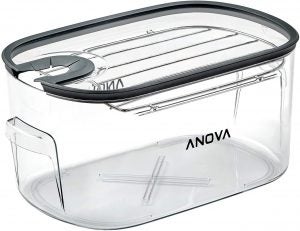
2. LIPAVI Sous Vide Containers
LIPAVI is a relatively new entrant to the sous vide world but it’s quickly becoming popular among sous vide enthusiasts. That’s not an accident, in fact we can barely contain our enthusiasm about this remarkable products! Their intelligent design and quality materials ensure that your sous vide cooking experience is flawless. And it’s all about the lid, funnily enough! When using polycarbonate containers for sous vide, many people want to use the lids that usually come with them to help prevent evaporation and temperature loss. However, to do so, they need to get crafty: get ready to pull our your knives and power tools and put them to work in order to create makeshift holes. Suffice it to say, not only that this can be dangerous, it gives you crappy results. LIPAVI understood this desire and created polycarbonate sous vide containers and lids with PRE-CUT holes for each sous vide device. This is an absolute game changer. You can actually pick a lid that corresponds to your sous vide machine, such as Anova, Gourmia, or Sansaire. The price tag is slightly higher than that of Cambro containers, but the pre-cut holes is what makes us place LIPAVI first on our list.
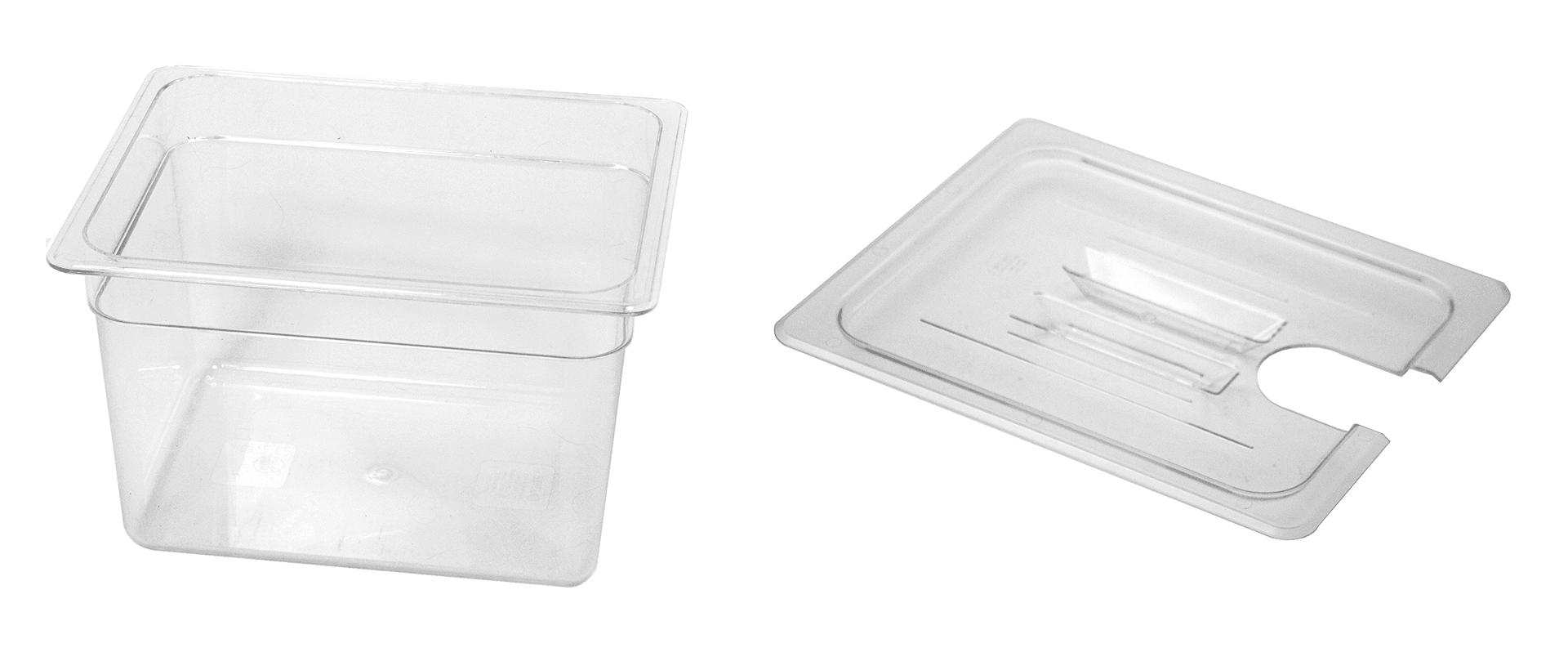
3. Cambro Sous Vide Containers
Cambro has long been a leading manufacturer of culinary food storage containers, and their polycarbonate containers are perfect for sous vide water baths. We’ve had the chance to use a 12-quart Cambro round container for one of our sous vide cooking reviews, and it worked perfectly. The material used to make this vessel is remarkably robust, and there’s no way you’d be able to break it by accident. Prior to this, we used to recommend the Rubbermaid container (see below), but the main reason for this was their BPA-free certificate. It ensured a peace of mind for many who are concerned about the harmfulness of chemicals in plastic, so it made Rubbermaid go-to and most recommended sous vide container.
So everything was going well for them and we were prepared to give them an easy high ranking. However, that has changed and now an asterix is necessary. Since they are no longer BPA-free, their rank definitely dropped in our reviews. In comparison, these Cambro containers definitely out-perform them in various aspects. The material is significantly stronger and seems way more resilient to accidental drops, and the lids that come with it attach more securely. The only potential downside is that the toughness of the material makes is difficult to cut through the lids. If you were planning to fit an immersion circulator with a lid, it might not be viable. However, if a lid isn’t necessary for you to achieve an optimal sous vide cooking experience, then Cambro is definitely the way to go!
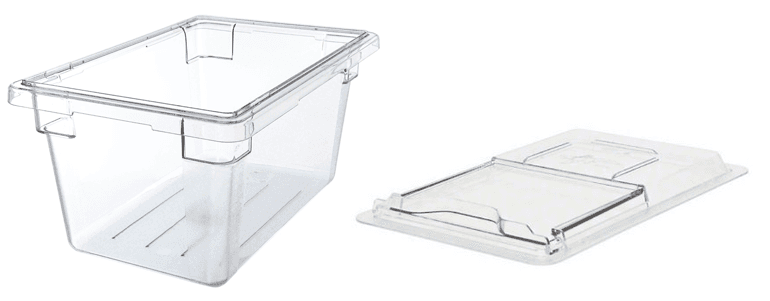
4. Rubbermaid Sous Vide Containers
Up until they switched to material that is not classified as BPA-free, the Rubbermaid Commercial Space-Saving Container was one of our highest recommended water baths for immersion circulators. While it’s currently outperformed by a few better options, this container is still a good choice if you’re not concerned about BPA. (And with sous vide, there’s not much reason to be, as outlined above). This water bath is dishwasher safe, and resists temperatures from -40 to 212 degrees F. This lends itself well to the needs of sous vide cooks. The side also has clearly marked measuring lines for adding the ideal amount of water, which will make the process easier. The measurements of the 12 quart container (which we use) come in at roughly 11 inches long, 10 inches wide, and 8 inches deep, providing ample space for multiple vacuum-packed bags. These containers also have multiple sizing options from 2 quarts all the way up to 22 quarts, and come with a lid included. Granted, the lid is made of a very flimsy plastic which makes it look and feel very cheap. On the other hand, they’re quite easy to cut through. We were able to cut a hole to fit an immersion circulator through with a small utility knife.
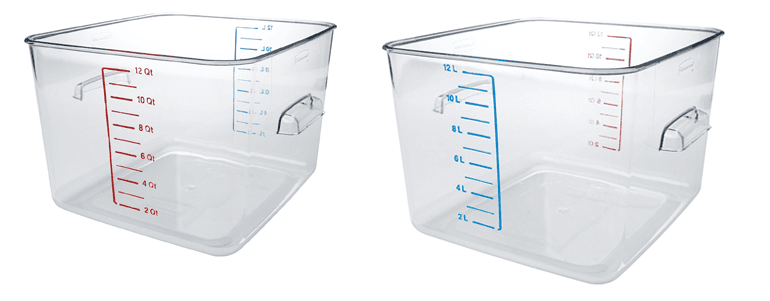
5. Plastic Coolers
Most people have at least one old plastic cooler laying around somewhere. Plastic coolers are usually a commonly owned household product- we all like our beer nice and cold. However, a with a few modifications, a plastic cooler can become a perfect vessel for your immersion circulator sous vide cooking. Inexpensive, easy to come around by, and fully functional- what more could anybody ask for?
Naturally, there are a few guidelines you need to follow if you want to transform a cooler into a water container for sous vide. If you plan on using plastic coolers for sous vide, first thing you need to do is make sure it is large enough. We recommend roughly 8” deep and that will hold at least 12 quarts of water. Since these coolers are made to be insulated, heat is held very well, so temperature will rise quickly with little power required from the cooker.
The most significant downside of using a plastic cooler as a container for sous vide is the questionable safety. The high temperatures of cooking water could pull chemicals off of the plastic liner and contaminate it. Because of this, we do not recommend using plastic coolers unless you can be sure that this alternative method won’t cause any harm.
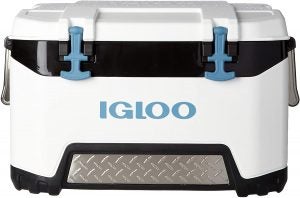
6. Pots
Even if you don’t have a plastic cooler, you definitely have a pot in your kitchen. But, while everyone owns a pot, not everyone has one that will be large enough for sous vide cooking!
Personally, this was the first water bath method I used when using an immersion circulator. I believe that everyone tries using the immersion circulator with a pot before deciding to upgrade to a high-quality sous vide water container. And everybody decides that, because a pot can only be a temporary solution. The downfall of using pots is that you can’t use the lid to hold in heat and prevent water evaporation, which requires more power from the cooker. We definitely recommend using a Cambro container over traditional pots because they are lightweight, offer more cooking space and come with sturdy lids that prevent evaporation and temperature change.
There is one exception, though. If you plan on using the new ChefSteps Joule immersion circulator, you’d find it more practical to use a pot over a plastic sous vide container. This innovative sous vide device has a magnetic bottom. Unlike most sous vide immersion circulators which use clips to attach to the side of a container, Joule uses a strong magnet on the base of the device which helps it stand upright in a pot.
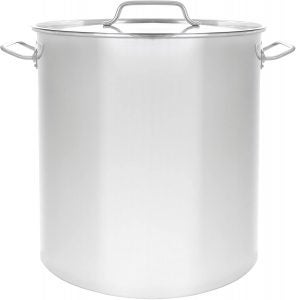
Overall, our honest recommendation is to purchase a polycarbonate, BPA-free, square food container WITH a lid. Ideally, if you want to skip the hassle of cutting out holes by yourself and potentially ruining the sous vide container, you’d opt for a container with pre-cut lids, such as the LIPAVI. After all, you’ve already spent between $100-$300 on an incredible sous vide immersion circulator- so why would you ruin the food by using inadequate containers?
Sous Vide Frequently Asked Questions
How do you use a Sous Vide immersion circulator?
Every Sous Vide immersion circulator is different. Even so, the general workflow is that you; (1) set the desired temperature in Fahrenheit or Celsius, (2) set the desired cooking window, (3) confirm your selection and begin heating. When the unit has reached its target temperature it will, typically, release a chime or a ding to let you know that you’re good to go.
Can you Sous Vide in any container?
Generally speaking we suggest either using a large stock pot or a purpose built water bath. There are plenty of these for sale online. Some of them even come with lids that allow for sneaky immersion circulator access through a hatch near the rim. Make sure to look for that BPA free badge. We can’t recommended anything that isn’t certified and chef-tested
How much water do I fill up in the container?
This depends on what you’re cooking, but as a general rule make sure to pay attention to the low minimum and maximum fill lines on your immersion circulator. Don’t forget that adding your vacuum-sealed food will displace water and increase your water level!
Can I use my kitchen sink as a “container” to Sous Vide?
We wouldn’t recommend this. Not only will this use a lot of water, but it’ll take a long time to heat up. Kitchen sinks are also, scientifically, 3-4 times more likely to be grosser than a pot you washed yesterday (research pending).
Can you Sous Vide in a 5 gallon bucket?
Although I’ve managed to make this work in the past, it’s a truly tricky prospect. It’s better to have a larger container and not need all of it than a smaller container that can’t keep a steady water level.
Are all Sous Vide containers BPA free?
If something is being marketed as a Sous Vide container it should, in an ideal world, be BPA free and safe at Sous Vide temperatures. With that said, we always recommend that you do your due diligence. It never hurts to be careful, especially when it comes to food.
Does Sous Vide need a lid?
Lids in Sous Vide are extremely useful for long cooks, such as those at the 24 hour and beyond mark. These cooking windows mean more water evaporation, which mean an increased chance of your machine auto-shutting off because the water levels got too low. For those interested in Sous Vide barbeque lids are particularly important.

Pingback:Oliso PRO Smart Hub Review: Reinventing Sous Vide Cooking - Sous Vide Guy
Pingback:Are Container Lids Necessary for Sous Vide? - Sous Vide Guy
Pingback:Sansaire Sous Vide Review: Stunningly Sleek and Simple - Sous Vide Guy
The manufacturer says the Rubbermaid containers are no longer certified as Bpa free. Do you know own of any other containers that are BPA free? Any other recommendations? TIA.
You are correct, thank you for the great find! We contacted them to confirm and they are in fact no longer BPA-free. We will update the article accordingly. As for BPA being present in sous vide containers, I’m not too worried about it so long as the bags you are using are BPA free. Basically, if the vacuum sealed bags (or ziplock bags) are BPA free, then no chemicals from the container should be able to affect your food.
I, however, am not a scientist specializing in BPA! I’d recommend anyone who is still worried about the effects of BPA to use pots instead of containers.
I’ve tried to extensively research the rubbermaid containers and theit website and other sources indicate that as of 2010 none of their container have BPA. Could you please tell me what this updated Inormation is based on? Ive been using that container extensively for my sous vide cooking
why the concern about the coolers if they are in a sealed bag???
Overall I feel as though a large enough aluminum or stainless steel pot with a heavy bottom works very well just cover it with plastic wrap right around the handles and you’re good to go very little evaporation and virtually no heat loss.
Metal conducts heat. Metal pots lose a ton of heat over a few hours cooking time.
Plastic does not hold heat particularly well. Once a metal pan heats up it would hold the heat better. That’s what pots do for a living. The net loss will be the same.
What? Thermal conductivity is not the same as thermal mass. Thermal conductivity means that heat will transfer through the mass easier. Think of it as the inverse of insulation. The net loss will not be the same. Metal will conduct the heat to the exterior of the vessel much easier than most plastics which are poor thermal conductors. Keep the heat in!
Pans are designed to transfer heat quickly. During sous vide, you don’t want the container to transfer heat, you want it to keep it in. Plastic is better, since it is a poorer conductor of heat.
Hi, I bought a sous vide cooker. It written maximum 15 liters, my question is if I use a 26 liters container but I pour 15 liters and add some ribs to bring to the maximum line. Do you think is it ok?
I hope you understand me, English is not my mother tongue .
yes — it just means your sous vide circulator isn’t powerful enough to reliably heat more than 15 gallons at a time and keep it at stable temperature within the range of the machine (ranges from 0.1 to 2 degrees depending on circulator quality). So you can use a bigger container and not put as much water in it. But keep in mind, operating at the maximum, especially if you have a highly conductive pan, no lid, etc. you might still have some fluctuation.
Since the food is sealed in a bag and doesn’t contact the water, why does it matter if the water bath is BPA free or not?
Hey Shorty – you’re right. We mention this in the post:
“BPA is only an issue if it comes in contact with the food you are cooking. With sous vide, our food is wrapped in a vacuum sealed bag or ziplock bag, preventing any BPA chemicals in the container from touching your food. In summary, as long as you are using BPA-free bags to hold your sous vide food, you are absolutely fine! Get whatever container your heart desires. We’ll dive through our favorites below.”
Then why not recommend the coolers too? Do they have chemicals that are able to seep through the average bag?
No they do not; we do have coolers listed above as a suitable container for sous vide. The mention about chemicals in coolers is more prevalent because coolers are often used for multiple purposes. For example, if you use it for a sous vide cook and then turn around and put your picnic lunch in there.
But I’m not in the science business.
You wrote the type of the container is not that important because the food is sealed and whatever chemicals can not pass through. Do you have a source for this because I would like to know more about it.
I am considering if there are any health risk when using a container made of polypropylene and if the polypropylene can wander through the plastic bag and into the subject being prepared. There has been examples of the color and smell of smoke passing through the plastic bag and into the water when preparing smoked food. Because of this, I am concerned if the opposite is possible? I am of course using sous vide approved bags.
My 850w Sous Smart circulator ($70 from Amazon) has no trouble keeping the water in an uncovered aluminum stock pot at 160°F. I doubt that it is heating continuously, but if it were, that amount of electricity would cost me slightly less than 10¢. (We pay Duke Energy 11½¢ per kilowatt-hour.) Of course cooking at lower temperatures costs less.
The polycarb containers you discuss cost on the order of $25. Assuming they save as much as 50% of the energy costs — quite unlikely — I’d have to do 500 hours of sous vide cooking to break even. I’m an enthusiast, but that’ll take a couple of years. Will the plastic containers last that long?
Geeking out on numbers aside, the polycarb container needs to be stored somewhere, and every kitchen in the world is short on storage space. The stock pot already has a storage place, because we use it for a lot of other things. All things considered, you haven’t made your point for me.
Hey Bob, I’ll ask you this – how much did the stock pot cost? 🙂
One of the important reasons for using polycarbonate containers is that you can cut the lids; sealing the water bath prevents evaporation which, during a long cook (24 – 48 hours), is very important. Stock pot lids can’t be cut for a perfect fit for your circulator.
“how much did the stock pot cost?”
We’ve had it for over 25 years (and used it a thousand times; we make a lot of stock. I can smell chicken stock simmering right now). It was probably about $50 back then, would be $100 now.
“sealing the water bath prevents evaporation which, during a long cook (24 – 48 hours), is very important.”
OK, that’s a challenge to a former experimental physicist.
I ran the circulator at 140°F plugged into a “kill-a-watt” power usage monitor (hate that name). The circulating blades run all the time, at a very low power level, and the heater was on 42% of the time at about 830 watts. It seems to be binary, on or off, nothing in between. Then, figuring the aluminum pot with an open top would lose more energy than the polycarb, I covered the top with saran wrap and wrapped the whole thing in dishtowels. The heater went down to a 34% duty cycle. Doing the arithmetic, the better heat-retention with the towels, assuming the polycarb would be as good, would save me 37¢ over a 48-hour cook. Note that the saran wrap would also prevent evaporation, even without the towels.
Anyhoo, I think that the larger consideration is storage space. We designed this house and have a lot of storage in the kitchen and walk-in pantry. Nonetheless, I wouldn’t want to add a large plastic container to what we store if it’s not necessary.
Thank you for this post… scientists make the world go round!
Hey Nix! It certainly does. Thanks for stopping on by.
I’ve been using the SV Supreme for years and just recently bought an Immersion circulator. I lucked out – my 5 gallon stock pot fits perfectly into a soft-side cooler I picked up on vacation one time. The lid even folds over leaving a gap for the circulator. I could add a towel if I wanted to get neurotic about it.
Towels are great for sealing, but you can also give saran wrap a try if you’d like. Glad to hear you’ve found a solution that works for you!
The issue is not about cost of heating.
It is about space in the container. Ribs, tenderloins, roasts, turkey–they don’t fit well in a round pot that has a lot of its diameter taken up by the machine. Don’t even try cooking for a big group. And fashioning a cover for long cooks is a hassle.
Try a rectangular 12qt+ plastic container and you will never go back. You probably have one laying around the house or choose your perfect size at Target. They come with a lid that can easily be cut to fit your machine.
BPA doesn’t matter, at least to me. My food does not contact the water.
Hey Jim! Great call. There’s nothing worse than an getting a rack of ribs only to find that they won’t fit in your water bath. Sure, you can sometimes cut them down to size but then you get stuck with more prep time. Since sous vide can be so time intensive I like to chop the minutes down where I can find them.
Target’s a great place to look for cheap plastic gallon containers – although I’ve been using Amazon recently.
After I got my wife an Anova for her birthday last year, the search was on for a proper sized pot. We ended up buying a 24qt stock pot at Sam’s Club for ~$35, and I used a dremel to cut out a portion of the lid to accomodate the Anova. Just be sure to put something UNDER the pot. We use cork potholders to insulate the countertop from the hot pot.
(https://www.samsclub.com/sams/24-qt-aluminum-stock-pot-with-lid/201782.ip?xid=plp:product:1:2)
Cork potholders are a great idea! When I first started doing sous vide my water bath was small enough that I was able to get away with using a baking sheet. Even then, it got a little too hot for my liking.
Regarding BPA:
BPA-free is essentially meaningless. What people fail to ask is, when they remove bisphenol A, what do they replace it with? The answer is basically Bisphenol S and F (BPS or BPF). These compounds are used because they are structurally extremely similar to BPA and perform the same function in plastics; there is no reason to think they’re any safer. We just that we don’t have any long-term studies about their effects on the human body. Manufacturers switched to them so they can say “we don’t use BPA!”
Basically, avoid plastics with the 7 symbol on them (though that number encompasses a number of different plastics). Type 2 (High-Density Polyethylene, or HDPE), Type 4 (Low-Density Polyethylene, or LDPE), Type 5 (Polypropylene) are the safer choices.
But since the food doesn’t come into contact with the water vessels, what they’re made of isn’t relevant.
This article talks about the dangers of the containers not mattering because the food is protected by plastic… but almost all commercially available plastics leach synthetic estrogens see (https://ehp.niehs.nih.gov/wp-content/uploads/119/7/ehp.1003220.pdf)
Are you sure the sealed food is protected? There has been examples of the color and smell of smoke passing through the plastic bag and into the water when preparing smoked food. Because of this, I am concerned if the opposite is possible?
Exactly right, Scott. A more pressing question is the quality of your vacuum sealable bags. That’s one of the (many) reasons I prefer to use something designed for sous vide rather than generic ziplock bags.
What can you say about the possibility of using containers from polypropylene? Polypropylene is better / worse than polycarbonate?
Hey Igor! To be honest, the biggest difference is probably the net environmental impact of the plastics. Polypropylene is manufactured with industrial chemicals like butane, benzene, and vinyl acetate (which isn’t to say polycarbonate is any better). Like mentioned elsewhere on this post, because the food doesn’t come in direct contact with the water what the container is made of is much less important than the vacuum sealable bag housing your sous vide meal.
I use an old aluminum stock pot to sous vide with an old Sansaire. I am concerned about wasted energy so I throw in some ping pong balls to cover the water surface, add a little Saran Wrap and wrap the whole thing in kitchen towels. I bet there is all kinds of danger lurking in the ping pong balls.
People use Igloo insulated coolers as mash tuns for homebrewing with the product coming in direct contact with the plastic 150-200 degrees. They (and if I’m not mistaken most plastic insulated coolers) are made with a polypropylene interior which is food safe up to about 260 fahrenheit and resistant absorbing or leeching foreign substances. It’s HIGHLY unlikely there are any legitimate safety concerns with using them for sous vide.
That’s definitely one of the advantages to working with polypropylene containers. They’re heat-resistant, and can stand up to repeat usage provided things don’t get too hot.
I know this is an old post, but here is a BPA free sous vide plastic tub I found. Yeah it’s really a cooler with a hole cut out for the Anova, but whatever, it works much the same and since I don’t see it listed above, thought I’d throw it out there.
Hey Emma! Not a problem at all. It’s always good to keep the conversation going. Sous vide is only growing more accessible over time, but that doesn’t mean homebrew customization is a thing of the past.
so, just curious. I cooked salmon last night in a stock pot with no insulation or lid (newbie, didn’t know about such things) and it was underdone at what I had researched should be the perfect temperature. If I insulate the pot and use the same time and temperature settings is it likely to turn out better? Thanks for all the helpful info!
Nancy
The use of a lid or insulation on the pot should not affect the doneness of the Salmon if the heater is able to keep the temperature up. As long as you cooked for long enough for the internal temperature of the fish to approach the water temperature, the results should be the same. As a sanity check, you might check both the water temperature and the internal temperature of the Salmon with a good instant read thermometer such as a thermopen.
Doneness, especially in fish, is a personal preference. It is entirely possible that you like tour fish a bit more done than the “perfect” temperature. Assuming that you hit the temperature you aimed for last time, try a degree or two higher next time. Because cooked fish temperatures are generally lower than those for other meats. going from the cooker to the mouth quickly is important as the already cool fish becomes cold quickly.
I have a Sansaire that is about 5 years old, frequently used, and still a delight. This week, one of the ears that holds the clip broke. I have contacted Sansaire about a replacement shell or shell part, but may have to improvise a bracket for the clip. Has anyone else had this problem? Any suggestions would be welcome.
I have a Frieling Sous Vide 5005 stick, 800 Watts. The directions say not to use a lid but the other ones I have been around used a Rubbermaid container with a
Everie hinged collapsible lid. Would this be compatible with the brand/model
I have ?